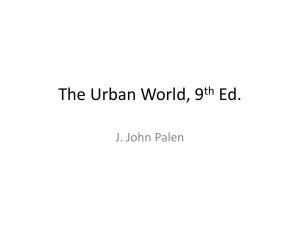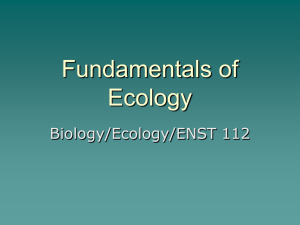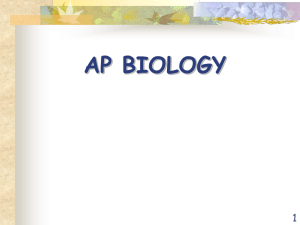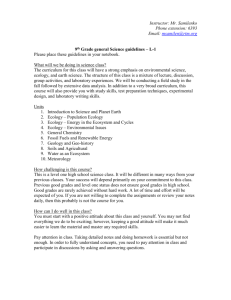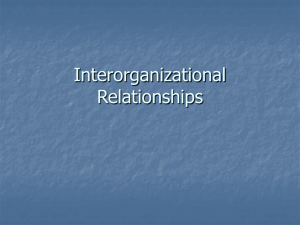Landscape Ecology - hypothesis testing
advertisement
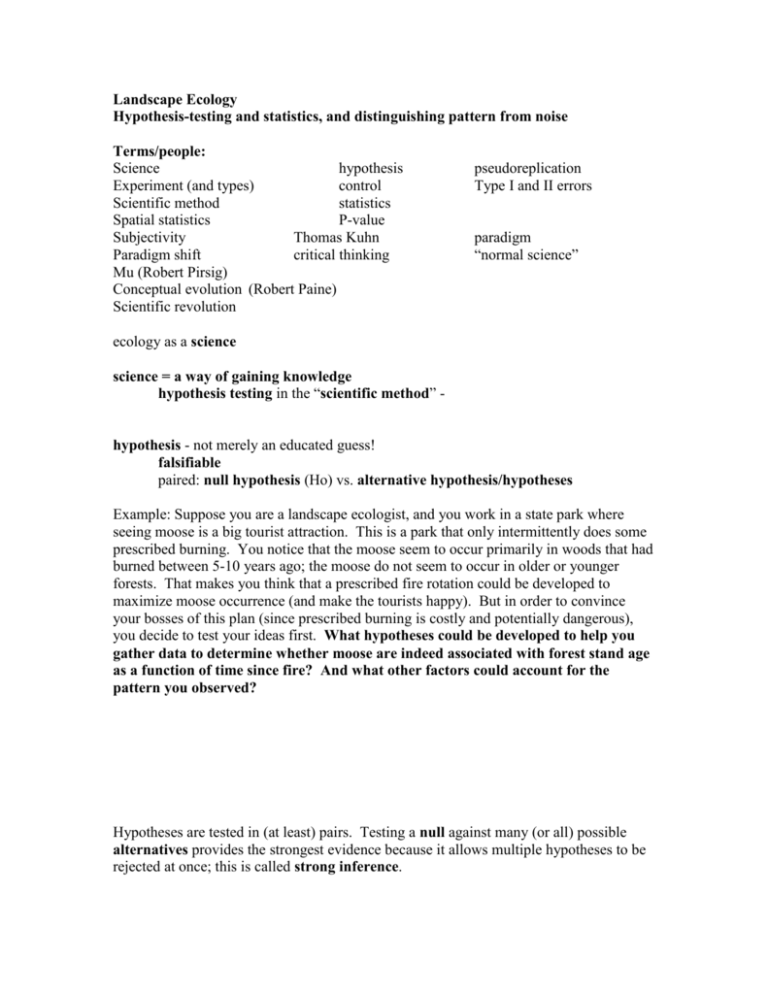
Landscape Ecology Hypothesis-testing and statistics, and distinguishing pattern from noise Terms/people: Science hypothesis Experiment (and types) control Scientific method statistics Spatial statistics P-value Subjectivity Thomas Kuhn Paradigm shift critical thinking Mu (Robert Pirsig) Conceptual evolution (Robert Paine) Scientific revolution pseudoreplication Type I and II errors paradigm “normal science” ecology as a science science = a way of gaining knowledge hypothesis testing in the “scientific method” - hypothesis - not merely an educated guess! falsifiable paired: null hypothesis (Ho) vs. alternative hypothesis/hypotheses Example: Suppose you are a landscape ecologist, and you work in a state park where seeing moose is a big tourist attraction. This is a park that only intermittently does some prescribed burning. You notice that the moose seem to occur primarily in woods that had burned between 5-10 years ago; the moose do not seem to occur in older or younger forests. That makes you think that a prescribed fire rotation could be developed to maximize moose occurrence (and make the tourists happy). But in order to convince your bosses of this plan (since prescribed burning is costly and potentially dangerous), you decide to test your ideas first. What hypotheses could be developed to help you gather data to determine whether moose are indeed associated with forest stand age as a function of time since fire? And what other factors could account for the pattern you observed? Hypotheses are tested in (at least) pairs. Testing a null against many (or all) possible alternatives provides the strongest evidence because it allows multiple hypotheses to be rejected at once; this is called strong inference. You will have to account for the variance among forest stands between years and the number of forests sampled (sample size) to eventually answer your question. In this example, you can sample each and every forest patch (the entire population of forests), but in many cases, this is impossible, so you must take a representative sample of the population. Smaller sample size increases the chance that you do not capture the variability of the whole population. scientific method (idealized): make observations ask question (i.e., develop a theory, defined below) form hypotheses (null and alternatives) test hypotheses (usually by experimentation) evaluate test results (usually by statistics) reject/retain hypothesis Reality is messier, not nearly as linear! (Click here for an example.) But use of this standardized method provides a common framework among scientists and minimizes variation (and thus, bias). Note that not all questions can be tested using the scientific method, such as “Is Bach’s music better than Beethoven’s?” or “Why is there suffering in the world?” The process of hypothesis testing using the scientific method was formalized by Karl Popper in 1930s and remains a key focus of modern ecology; often called hypotheticodeductive method (H-D or Popperian method). Popper 1970 - science vs. pseudoscience (e.g. astrology) - both “reek” with explanatory power and are full of verifications real science proscribes events (no cop-outs allowed) focus should be on trying to falsify Ho; can never “accept” Ho, only fail to reject it Type I error Type II error When you fail to reject Ho, there may be 4 reasons: 1) 2) 3) 4) experiment = treatment vs. control (controls variability) classic experiment – “natural experiment” (sensu Diamond 1986) – pseudoreplication (Hurlburt 1984) – scientific "laws" What about laws in ecology? critical thinking Recommended reading: How to Think about Weird Things by T. Schick and L. Vaughn. Hypothesis testing is a technique of statistical inference that allows two formulations of a problem to be compared using objective methods. A statistical hypothesis is a statement about the parameters of a probability distribution. Statistics is the field that allows a scientist to compare sources of variance of observed phenomena, to help to decide whether to accept or reject hypothesized relations between phenomena, and to aid in making reliable inferences from observations. “In biology most phenomena are affected by many casual factors, uncontrollable in their variation and often unidentifiable. Statistics is needed to measure such variable phenomena with a predictable error and to ascertain the reality of minute buy important differences. Whether biological phenomena are in fact fundamentally deterministic and only the variety of causal variables and our inability to control these make these phenomena appear probabilistic, or whether biological processes are truly probabilistic, as postulated in quantum mechanics for elementary particles, is a deep philosophical question.” (Sokal and Rohlf 1969:5) Hypothesis evaluation is usually done via statistics, using probability theory (the P of a P-value stands for "probability") P < 0.05 (or sometimes 0.10) is the standard level of error tolerance (< 5%) But statistical significance does not always signify ecological significance! Use of statistics in LE is crucial because of autocorrelation (vs. stationarity = uniformity of pattern) – Tobler’s first law of geography – “everything is related to everything else, but near things are more related than distant things” (1970) isotropy = concentric decay function anisotropy = not concentric (e.g. seed rain for wind-dispersed species) There are some experimental/statistical techniques that can be used to minimize spatial effects, including randomization, blocking, and replication (and then averaging across replicates). Spatial statistics emerged in the 1980s, first in the geosciences for use in mining (hence the synonym of “geostatistics”). SS is becoming a powerful tool for landscape ecologists. Even so, SS has spatial assumptions (e.g. Ripley’s K assumes isotropy) While it is true that not all landscape ecologists use SS (many use traditional stats or no stats at all!), SS is a very useful set of tools to have. Patterns, processes, and cause-effect relationships objectivity vs. subjectivity in science How do we minimize this subjectivity that can cloud our judgement? 1. Use of the scientific method (formulation of testable, falsifiable hypotheses) 2. Peer-review of results Even with these safeguards, however, problems may arise when the scientific community as a whole operates under a specific worldview that considers alternatives to be trivial idiosyncracies or the results of flawed research. Why is this important? Our preconceptions (worldview, epistemology) color how we determine pattern and process, what we think is important and timely, and therefore what kind of science we do. “Pattern, like beauty, is...in the eye of the beholder” - Grant face in the tortilla analogy paradigm Observations, patterns, explanations, hypotheses, concepts, theories, methodologies, and preconceptions all converge in the development of paradigms within a science. Paradigms, according to Thomas Kuhn (below), combine all of these into a coherent tradition of scientific research. Paradigms cannot be tested and they cannot be said to be true or false; they are simply epistemologies. Thomas Kuhn 1970 - The Structure of Scientific Revolutions “normal science” Paradigms are useful in structuring/organizing thought: fashionable science intellectual chauvinism "scientific revolution" paradigm shift “A new scientific truth does not triumph by convincing its opponents and making them see the light, but rather because its opponents eventually die, and a new generation grows up that is familiar with it.” (Max Planck, as quoted in Kuhn 1970) examples of paradigms and revolutions: 1) evolution by natural selection vs. creationism, Lamarckianism 2) nonequilibrium/chance/stochasticity vs. “balance of nature” (equilibrium) more in future lectures 3) patch matrix vs. mosaic view of landscapes (topic of later lectures) scientific revolution vs. conceptual evolution (Paine 2002) Has there been a shift in how we think paradigms change? concept of “mu” (Pirsig 1974, p. 288; see also Wiens 2007) So today’s take-home message is to try to step back and objectively view your worldview: is it hindering you? Are you reasoning objectively? What are the alternatives to your paradigm? And what about the studies that we will examine? What are the paradigms under which the studies were conducted? Consider this quote from fiction’s greatest thinking machine: “I make a point of never having any prejudices and of following docilely wherever fact may lead me.” - Sherlock Holmes (A.C. Doyle, “The Reigate Squires”) References: Note: The journal Ecology vol. 83 no. 6 from June 2002 has a special feature on paradigms in ecology. A couple of the refs below come from this issue. Armstrong, D.P. 1991. Levels of cause and effect as organizing principles for research in animal behaviour. Can. J. Zool. 69:823-829. Berryman, A.A. 2003. On principles, laws and theory in population ecology. Oikos 103:695-701. Cale, W.G., G.M. Henebry, and J.A. Yeakley. 1989. Inferring process from pattern in natural communities. BioScience 39:600-605. Colyvan, M., and L.R. Ginzburg. 2003. Laws of nature and laws of ecology. Oikos 101:649-653. Diamond, J.M. 1986. Overview: laboratory experiments, field experiments, and natural experiments. Pp. 3-22 in: Community Ecology (J. Diamond and T.J. Case, eds.). Harper & Row, New York, NY. Fagerström, T. 1987. On theory, data and mathematics in ecology. Oikos 50:258-261. Graham, M.H., and P.K. Dayton. 2002. On the evolution of ecological ideas: paradigms and scientific progress. Ecology 83:1481-1489. Hilborn, R., and S.C. Stearns. 1982. On inference in ecology and evolutionary biology: the problem of multiple causes. Acta Biotheoretica 31:145-164. Hurlbert, S.J. 1984. Pseudoreplication and the design of ecological field experiments. Ecol. Monogr. 54:187-211. Johnson, D.H. 2002. The role of hypothesis testing in wildlife science. J. Wildl. Manage. 66:272-276. Krebs, C.J. 2000. Hypothesis testing in ecology. Pp. 1-14 in: Research Techniques in Animal Ecology: Controversies and Consequences (L. Boitani and T.K. Fuller, eds.). Columbia University Press, New York, NY. Kuhn, T.S. 1970. The Structure of Scientific Revolutions (2nd ed.). University of Chicago Press, Chicago. Lawton, J.H. 1999. Are there general laws in ecology? Oikos 84:177-192. Loehle, C. 1987. Hypothesis testing in ecology: psychological aspects and the importance of theory maturation. Quarterly Review of Biology 62:397-409. Loehle, C. 1988. Philosophical tools: potential contributions to ecology. Oikos 51:97104. Loehle, C. 1990. Philosophical tools: reply to Shrader-Frechette and McCoy. Oikos 58:115-119. MacArthur, R.H. 1972. Geographical Ecology. Harper & Row, New York, NY. McAllister, J.W. 1998. Is beauty a sign of truth in scientific theories? Am. Sci. 86:174183. Murray, B.G. 2000. Universal laws and predictive theory in ecology and evolution. Oikos 89:403-408. Paine, R.T. 2002. Advances in ecological understanding: by Kuhnian revolution or conceptual evolution? Ecology 83:1553-1559. Peters, R.H. 1991. A Critique for Ecology. Cambridge University Press, Cambridge, UK. Pickett, S.T.A., J. Kolasa, and C.G. Jones. 1994. Ecological Understanding: The Nature of Theory and the Theory of Nature. Academic Press, New York, NY. Pirsig, R.M. 1974. Zen and the Art of Motorcycle Maintenance. William Morrow and Co., New York, NY. Popper, K.R. 1959. The Logic of Scientific Discovery. Hutchinson, London, UK. Popper, K.R. 1970. Normal science and its dangers. Pp. 51-59 in: Criticism and the Growth of Knowledge (I. Lakatos and A. Musgrave, eds.). Cambridge University Press, Cambridge, UK. Shrader-Frechette, K.S., and E.D. McCoy. 1990. Theory reduction and explanation in ecology. Oikos 58:109-114. Shrader-Frechette, K.S., and E.D. McCoy. 1993. Method in Ecology. Cambridge University Press, Cambridge, UK. Sokal, R.R., and F.J. Rohlf. 1969. Biometry. W.H. Freeman and Co., San Francisco, CA. [a book that should be on every professional biologist’s shelf] Tobler, W.R. 1970. A computer movie simulating urban growth in the Detroit region. Economic Geography 46:234-240. Wiens, J.A. 2007. The dangers of black-and-white conservation. Conservation Biology 21:1371-1372.

